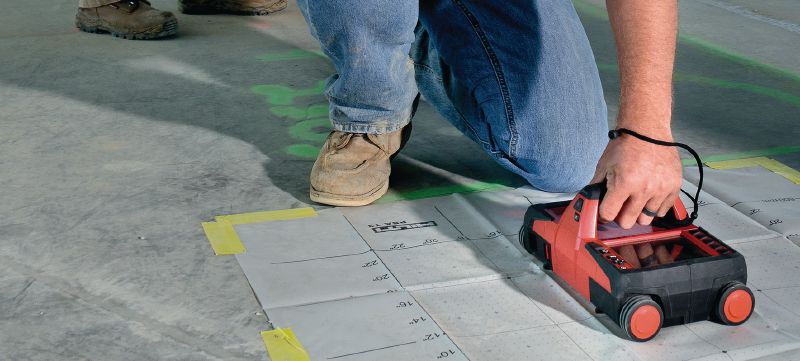RainierGPR Concrete Scanning Demystified: Whatever You Need to Know
RainierGPR Concrete Scanning Demystified: Whatever You Need to Know
Blog Article
Checking Out the Midst: A Comprehensive Overview to Concrete Scanning and Its Diverse Applications
In the realm of building and construction and infrastructure growth, the careful procedure of concrete scanning holds a crucial role in making sure the architectural honesty and security of projects. As innovation continues to advance, the applications of concrete scanning have expanded far beyond plain surface-level evaluations.
Value of Concrete Scanning
Recognizing the value of concrete scanning is important in making certain the safety and security and stability of frameworks during building and restoration jobs. Concrete scanning utilizes sophisticated technologies such as ground-penetrating radar (GPR) and electro-magnetic induction to detect embedded things, gaps, or various other anomalies within concrete structures.
Furthermore, concrete scanning plays a pivotal duty in making certain conformity with building codes and guidelines that mandate the security of existing structural elements during building and construction tasks. By precisely mapping out the interior structure of concrete, scanning technologies enable building and construction professionals to make enlightened choices that promote the structural stability and toughness of structures and framework jobs. Basically, the importance of concrete scanning depends on its capability to secure both the architectural integrity and the employees included in building undertakings.
Technologies Utilized in Concrete Scanning
Concrete scanning relies on innovative innovations such as ground-penetrating radar (GPR) and electro-magnetic induction to properly discover ingrained items and abnormalities within concrete frameworks. Ground-penetrating radar operates by sending out high-frequency electromagnetic waves right into the concrete. When these waves experience various products or spaces within the concrete, they recuperate to the surface, permitting the GPR system to produce a detailed subsurface photo. This innovation is particularly efficient in finding rebar, post-tension cords, conduits, and other things embedded in concrete.
Electro-magnetic induction, on the various other hand, works by producing magnetic fields around a concrete structure with a transmitter coil. When steel things are present within the concrete, they interrupt these electro-magnetic areas, causing eddy currents to flow with the steel. By gauging the adjustments in the magnetic fields with a receiver coil, the system can pinpoint the place of metal items in the concrete.
These cutting-edge innovations play an important function in non-destructive screening, making certain the safety and security and honesty of concrete structures in various industries.
Applications in Building Market
Within the building and construction market, concrete scanning technology finds varied applications that enhance task efficiency and safety and security. Additionally, concrete scanning is made use of for finding gaps, such as air pockets or areas of deterioration within concrete, which can compromise the overall strength of a structure. Concrete scanning plays a critical duty in high quality control by verifying the thickness of concrete covers over support, ensuring conformity with design specs and criteria.

Security Benefits of Concrete Scanning
In the world of building security, the application of concrete scanning modern technology presents a vital benefit in preemptively determining prospective dangers and fortifying structural honesty. By utilizing advanced scanning approaches such as ground-penetrating radar (GPR) web and electro-magnetic induction, construction teams can accurately locate rebar, post-tension cords, conduits, and other hidden items within concrete structures. This proactive approach significantly decreases the risk of accidental strikes throughout boring, reducing, or coring activities, therefore protecting against pricey damages, injuries, and project hold-ups.
In addition, concrete scanning enhances employee safety and security by offering real-time info concerning the structural problem of concrete elements. By attending to possible security concerns immediately, concrete scanning adds to creating a safe and secure working setting and mitigating the probability of architectural failures or mishaps on construction sites.
Future Patterns in Concrete Scanning
Emerging developments in scanning innovation are positioned to transform the area of concrete assessment and evaluation. By taking advantage of the power of AI, these systems can examine huge amounts of information accumulated throughout scanning processes to offer more in-depth and precise understandings right into the condition of concrete structures.
An additional substantial fad is the growth of more straightforward and portable scanning gadgets. Miniaturization of scanning devices enables simpler access to constrained spaces and remote places, making inspections more efficient and thorough. Furthermore, developments in cordless interaction technologies enable real-time information transfer and analysis, promoting quicker decision-making procedures.
Furthermore, there is an expanding concentrate on sustainability in concrete scanning technologies - RainierGPR Concrete Scanning. Suppliers are progressively incorporating green products and energy-efficient functions into their tools go to this site to minimize environmental effect. These future patterns are readied to improve the effectiveness, precision, and sustainability of concrete scanning practices, forming the market's future landscape
Verdict
To conclude, concrete scanning plays an important duty in the construction industry by making sure the safety and effectiveness of numerous jobs. By using innovative technologies, such as GPR and radar imaging, experts have the ability to accurately identify possible dangers within concrete frameworks. The applications of concrete scanning are large and remain to progress, making it a crucial device for keeping the integrity of structures and framework. As modern technology developments, the future of concrete scanning holds appealing developments for boosting construction procedures.

Report this page